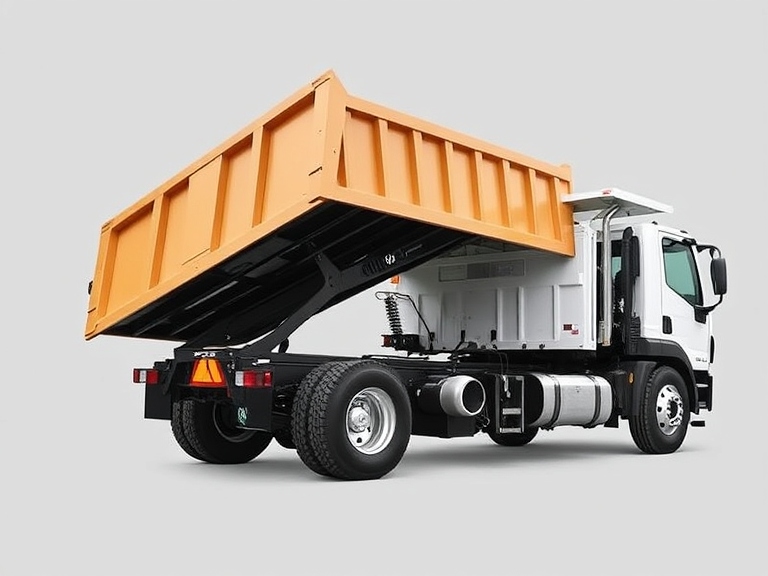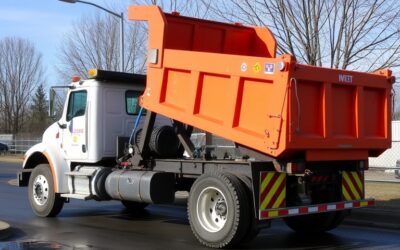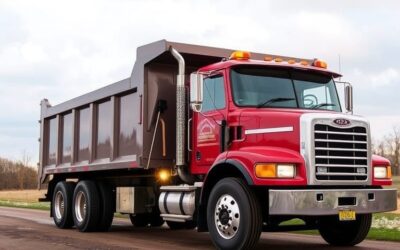Frame type dump trucks are essential for heavy-duty work in construction, mining, and waste management. But with their heavy loads, they’re at high risk for tipping—making safety a top priority. However, their design makes them vulnerable to tipping. Ensuring their stability and safety is crucial for preventing accidents and maintaining productivity.
Tipping risks arise from various factors, including uneven load distribution, rough terrain, and sharp turns. Even experienced drivers can find it challenging to navigate these conditions without the right safety measures in place. Understanding these risks is the first step in protecting your frame type dump truck.
Tipping Risks for Frame Type Dump Trucks
Frame type dump trucks face serious tipping risks, especially from uneven loads, rough terrain, and sharp turns. These factors can make even a well-operated truck unstable. One of the primary risks is uneven load distribution. When the load is not balanced, the truck becomes unstable. This is especially true when the load shifts during transit, causing the truck to lean and potentially tip over.
Rough terrain also poses a significant risk. Many dump trucks operate on construction sites, mines, and other uneven grounds. Driving on slopes or over large obstacles can tilt the truck dangerously. The higher the center of gravity, the easier it is for the truck to tip over. Even small bumps can create big problems if the load is heavy and not properly secured.
Another risk factor is high-speed turns. While dump trucks are built for power, they can struggle with stability when taking sharp turns at high speeds. The momentum can cause the truck to lose balance and tip. Drivers need to be aware of their speed, especially when making turns with a full load.
Essential Safety Tips for Operating Frame Type Dump Trucks
Operating frame type dump trucks safely involves following essential tips to reduce the risk of tipping. Here are some key practices to keep in mind:
1. Load Evenly:
– Distribute loads evenly to keep the truck’s center of gravity balanced. Avoid overloading or piling materials too high for added stability.
– Avoid piling materials too high. A lower, evenly distributed load is more stable and less likely to shift.
2. Monitor Terrain:
– Watch the terrain carefully. Avoid slopes and rough patches, and if you must drive on uneven ground, go slow and choose the safest path.
– If you must drive on uneven ground, go slowly and carefully. Take time to assess the safest path before moving the truck.
3. Control Speed:
– Control speed, especially when turning or carrying heavy loads. Slow down before turns to prevent tipping from sudden shifts.
– Slow down before making turns. Turning too quickly can easily cause the truck to tip over.
4. Regular Maintenance:
– Perform regular maintenance checks on tires, brakes, and suspension to keep your truck in safe working condition.
– Address any mechanical issues promptly to prevent accidents caused by equipment failure.
5. Use Safety Technology:
– Install Wink Anti-Tip for proactive stability monitoring and automatic adjustments that keep your truck safe.
– Training drivers on how to use these devices properly is essential for maximizing their benefits.
By following these safety tips, you can significantly reduce the risk of tipping and ensure safer operation of frame type dump trucks. Proper precautions and good practices are key to keeping both the equipment and its operators safe.
Installing Wink Anti-Tip on Frame Type Dump Trucks: A Step-by-Step Guide
Installing Wink Anti-Tip on your frame type dump truck protects it from tipping and keeps your operations safe. Here’s a simple step-by-step guide to help you through the installation process:
1. Preparation:
– Gather all necessary tools and components, including Wink Anti-Tip’s sensors, mounts, and control unit. Park on a stable, flat surface before starting.
– Park your truck on a stable, flat surface. Turn off the engine and secure the truck to prevent any movement during installation.
2. Mounting the Sensors:
– Mount sensors in recommended spots to monitor tilt and load balance. Follow the installation guide for accurate placement. Follow the guidelines in the installation manual for accurate placement.
– Use the provided mounts to secure the sensors firmly. Ensure they are positioned correctly to monitor tilt and load balance effectively.
3. Installing the Control Unit:
– Mount the control unit securely inside the cabin within easy reach of the driver. It should be within easy reach of the driver.
– Connect the control unit to the sensors using the provided wiring. Follow the wiring diagram in the manual to ensure proper connections.
4. Calibration:
– Power up the system and follow the control unit’s calibration guide for accurate readings. The control unit will guide you through the calibration process.
– Calibrate the sensors to ensure they provide accurate readings. This may involve tilting the truck safely within specific limits.
5. Testing:
– Run tests to ensure all features, including alerts and automatic adjustments, work smoothly. Test the alerts, automatic lowering mechanism, and visual indicators.
– Make necessary adjustments to enhance accuracy and responsiveness.
By following these steps, you can install Wink Anti-Tip efficiently, enhancing the safety and stability of your frame type dump truck.
Key Benefits of Using Wink Anti-Tip for Frame Type Dump Trucks
Using Wink Anti-Tip offers numerous benefits for frame type dump trucks, ensuring they remain safe and stable during operations. Here are some key advantages:
1. Enhanced Safety:
– Wink Anti-Tip provides real-time stability monitoring, helping prevent tipping and alerting drivers instantly to risks. It continuously monitors stability and makes real-time adjustments to keep the truck upright and balanced.
– The system provides immediate alerts to the driver, allowing for quick corrective actions before a critical tipping point is reached.
2. Cost Savings:
– Preventing tip-overs saves on repair costs, medical expenses, and downtime, protecting your bottom line. With Wink Anti-Tip, you save money by minimizing the risk of tipping incidents.
– Downtime due to accidents is also reduced, keeping your operations running smoothly and efficiently.
3. Improved Efficiency:
– With automatic adjustments and real-time alerts, drivers can focus on tasks without constant worry about tipping risks. The automatic adjustments and real-time alerts mean they can focus more on their tasks rather than constantly worrying about tipping risks.
– The system’s user-friendly design integrates seamlessly with existing truck systems, requiring minimal driver input.
4. Extended Truck Lifespan:
– Reducing tipping strain extends truck life, keeping your fleet in optimal condition for longer. A well-protected truck performs better and lasts longer.
– Regular use of Wink Anti-Tip ensures your trucks are maintained in optimal condition, leading to long-term benefits for your fleet.
Overall, the benefits of Wink Anti-Tip go beyond immediate safety advantages. They include significant cost savings, improved efficiency, and prolonged truck longevity.
Conclusion
Frame type dump trucks are essential but prone to tipping. With Wink Anti-Tip, you can enhance safety, cut costs, and keep your fleet running efficiently. Understanding these risks and implementing key safety measures can greatly reduce the chance of accidents. Wink Anti-Tip provides a comprehensive solution to these challenges, ensuring your trucks stay stable and your operations run smoothly.
Installing Wink Anti-Tip on your frame type dump trucks is a straightforward process that can yield significant benefits, including enhanced safety, cost savings, improved efficiency, and extended truck longevity. By investing in this technology, you protect not only your vehicles but also your personnel and your bottom line.
Discover how Wink Anti-Tip can improve safety and efficiency for your dump trucks. Our advanced anti-tip over device offers unmatched stability on any job site. Explore Wink Anti-Tip today for more information.





